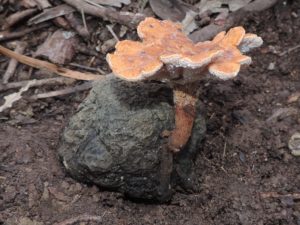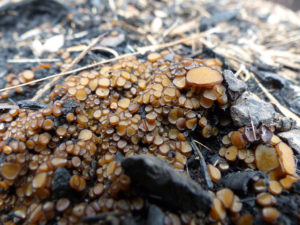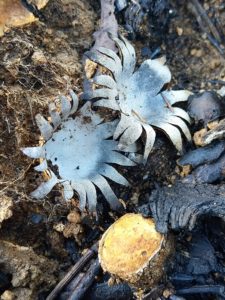
Dr Sapphire McMullan-Fisher
After the widespread fires, many people are returning to these areas to monitor the recovery of bushlands. We are hoping that you will help us understand how Australian fungi respond after fire.
If you are in a fire-affected area and you see a fungus please submit it to our iNaturalist project Fungimap Australia.
Fungi that are triggered to fruit after fire are often called pyrophilous (fire-loving) fungi. Fungi can be some of the first species to respond after fire with stonemaker fungi sometimes pushing up through the ash bed even before the first rains. These are saprobic or rotter fungi that are decomposing woody debris and buried wood. Another saprobic fungi that responds after fire is Pyronema, the orange mycelium of which can sometimes be seen en masse. This mycelium, and that of other species that survive fire whose threads remain unseen, are important for holding together the ash and soil, and helping prevent erosion.
Other ‘fire fungi’ are disc and cup fungi that are commonly seen fruiting after fire in large numbers in a variety of colours including orange, red, brown, and even black and grey. We now know that many of these discs and cups are mycorrhizal including Geopyxis carbonaria and Peziza tenacella. These mycorrhizal species are spreading their spores across the fire ground so they are ready to partner with the newly germinating generation of plants.
Where ground-dwelling marsupials like bandicoots, bettongs, potoroos, bilbies and quenda survive, they dig up the fire-stimulated truffles like Mesophellia species, and Star Truffle (Nothocastoreum cretaceum) among others. This digging and feasting across the fire ground also helps spread spores of the mycorrhizal associates of a new generation of plants. Laccaria, an important group of mushroom-shaped mycorrhiza, also may fruit en masse after fire.
Although a suite of fire-adapted fungi is discussed in this article, many fungi do not survive fire as their habitats – leaf litter, logs or topsoil – are lost or sterilised through burning, or they die because their plant partners die and most mycorrhizal fungi depend on their living plant partners. Where fires have been patchy, some fungi may survive and are important to spread their spores into the new returning vegetation. Unfortunately the drought conditions that precipitated the recent catastrophic fires mean that many fungi populations may have already been under extreme stress and where fires burnt through the organic layers of soil there may be nothing left in the ‘spore bank’.
Below are some post-fire fungi to look out for. Recording the progression of fungi that appear as your local vegetation recovers will help us learn more about our fungi. Most studies on fire fungi in Australia are several decades old so we need data on how our fungi are responding to current conditions in the varied landscapes affected by fire. We hope that land management agencies will include data in their analyses of fire recovery as the absence of some of these groups of fungi could be signs of unhealthy ecosystems and need more active restoration.
Stonemaker fungi

This group of decomposer fungi – Laccocephalum, Neolentinus and Pleurotus tuber-regium – produce storage organs are called sclerotia. These are often rotting large woody materials like logs, stags, and stumps, sequestering nutrients into storage organ allow them to rapidly put up fruit bodies and spread spores to land on new substrate to start their life cycle again. It is important to remember that logs, branches and even leaves maybe considered ‘waste’ are actually the nutrients that will be recycled to feed the new generation of plants and animals as the ecosystem regenerates from fire.
Stonemaker fungi are both adapted to fire and long periods without fire where they recycle wood and other organic materials. These and other ‘rotter’ fungi mycelia are food for wood and litter-inhabiting invertebrates. The recycling of organic materials is an important part of the food web: fungi are food for invertebrates, that in turn are food for ‘insectivorous’ birds. Removal of wood and other organic material removes this part of the nutrient cycle and causes less healthy ecosystems and species extinctions.
Some descriptions of the more recognisable Stonemaker fungi:
- Laccocephalum hartmannii – Chestnut Polypore – (a lost fungus)
- Laccocephalum mylittae – Native Bread
- Neolentinus dactyloides – Leathery Sawgill
Disc and cup fungi

These ‘discomycetes’ are the sporebodies of some ascomycetes. Some are mycorrhizal ascomycetes, often seen are Geopyxis carbonaria and Peziza tenacella. Other disc and cup fungi are saprobic, like Anthracobia muelleri and contribute to nutrient cycling.
Truffles
Australia is a centre of diversity for truffle-like fungi – a common adaptation to a drying environment. Rather than spread their spores on air currents like many fungi, these fungi are adapted to being dispersed in the scats of ground-dwelling marsupials. The extinction of many of these marsupials means these fungi-eating specialists are no long around to act as a matchmaker between plants and fungi. So plants only have the nearby surviving mycorrhizae to depend upon for survival.

Some truffle-like fungi like Mesophellia species and Star Truffle (Nothocastoreum cretaceum) are adapted to fruit after fire. This gives a food source for fungi-eating mammals and spreads their spores around ready to partner with the regenerating plants.
Other fire-adapted fungi
Laccaria are a small mushroom shaped mycorrhiza that often fruits prolifically after fire. Again, this is good timing for these fungi to sporulate and find new plant partners. In other parts of the world, fire is considered to be an important trigger for the fruiting of Morels (Morchella) species. This has not been recorded in Australia, but it would be good to collect good evidence of which fungi DO fruit as fire affected areas recover.
Fungi after fire give hope

Evidence of sporebodies, like discs and cups, stonemaker fungi, mushrooms and other shaped fungi after fire is important, their presence indicates that there is an active return of spores into the recovering environment.
Please read the section and links below to learn how to record the best information and images to help us understand how our fungi respond to these fires through our iNaturalist project Fungimap Australia.
Tips for clear images
Set the fungi up so that you can see as many features in one shot or take several images showing important features.
- Get close, use macro settings or apps where possible
- Have good light without glare, use tripods, timers, diffuse lights in low light conditions
- Use Aperture-priority or image stacking modes
At least one image should include:
- Add size like a ruler or 5 cent piece ‘echidna’
- A white point object like a label to help with digital colour corrections
- Mirrors can help with under surface shots
- Fungi habitat*
Capture ephemeral features:
- Colour changes, milk etc.
- Stem base like discs etc.
- Veil remains, rings, volvas etc.
*Habitat images are particularly important after disturbance events as they give users information about conditions at the site. For example, they can show if the area was severely burned or if patches of litter or vegetation survived the fire. As the iNaturalist identification algorithm works on the first images posted, habitat shots are better last.


